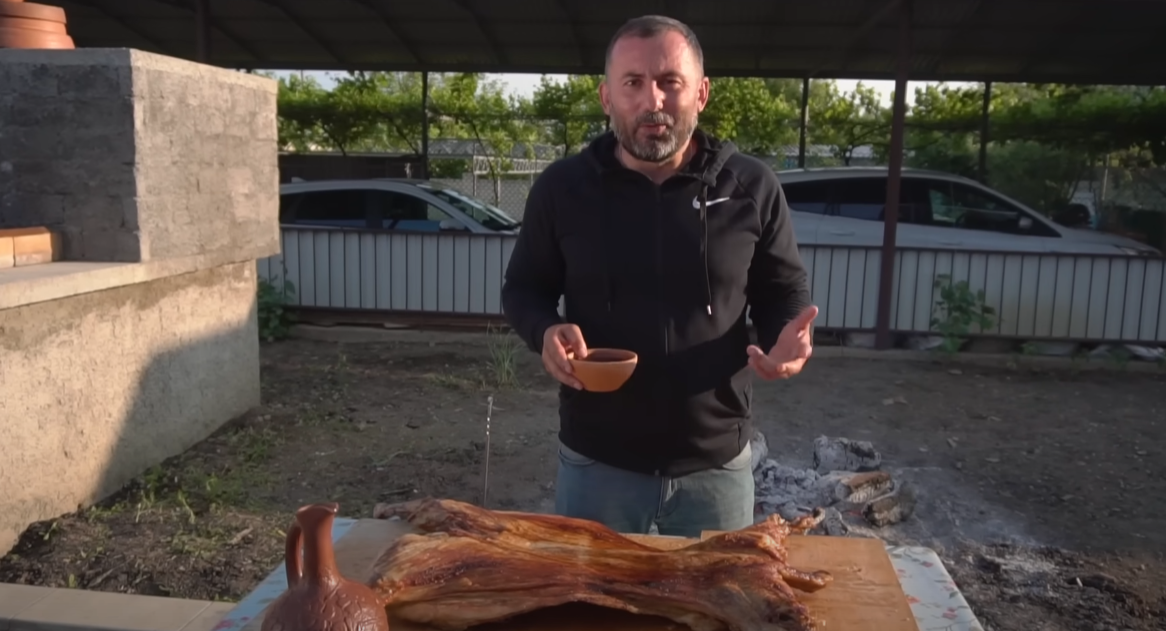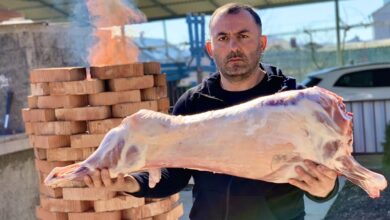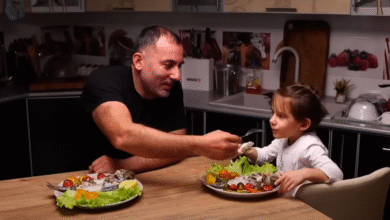Food
LAMB ON AN OPEN FIRE – GEORY KAVKAZ

🔪 1. INGREDIENTS (Serves 6–8 people)
-
2–3 kg lamb meat, preferably bone-in cuts like leg, shoulder, ribs, or a whole lamb quarter
-
1.5 tablespoons coarse salt
-
Juice of 1–2 lemons (freshly squeezed)
-
200–300 ml clean water
-
Freshly ground black pepper, to taste (optional)
-
Optional flavorings:
-
1 tsp paprika
-
Fresh rosemary or thyme sprigs
-
A few garlic cloves, crushed
-
Note: Georgy keeps things simple to allow the natural taste of the lamb and fire to shine—no heavy marinades or spice blends.
🧂 2. PREP & MARINATE
- Clean and trim the lamb if needed. Remove any excess fat or sinew, but leave a thin layer of fat for moisture during cooking.
- Use a sharp knife to make shallow incisions into thick parts of the meat to help it cook evenly.
- Place the lamb in a large bowl or tray.
- Sprinkle coarse salt generously on all sides. Rub it in well using your hands. Salt is both seasoning and tenderizer in this method.
- Squeeze fresh lemon juice over the lamb. Make sure it seeps into the incisions and surfaces. The citrus gives a touch of brightness and also helps soften the meat.
- Let the lamb rest for at least 30–40 minutes at room temperature while you prepare your fire.
- (Optional) Add crushed garlic and herbs to the meat if you want an aromatic touch—but Georgy typically avoids this to keep it traditional.
🔥 3. BUILDING THE OPEN FIRE
The Setup:
- Build a campfire using dry hardwood or charcoal. Avoid resinous wood like pine which adds bitterness.
- Burn the fire for at least 1.5–2 hours until you’re left with a glowing bed of white-hot embers.
- Once flames die down, spread the coals evenly to create a consistent heat source.
- Use rocks, bricks, or a grill rack to suspend the meat above the coals.
- If you’re using metal skewers or hanging hooks, make sure the meat doesn’t directly touch the embers—radiant heat is key.
🍖 4. COOKING THE LAMB OVER EMBERS
- Place the lamb cuts directly over the embers or suspend from hooks above the pit. Keep about 25–30 cm (10–12 inches) from the coal bed.
- Let the meat sear slowly—turn or rotate it every 10–15 minutes to ensure even cooking and prevent burning.
- Every 15–20 minutes, splash a small amount of water (2–3 tbsp) onto the lamb or coals. This creates a gentle steam that keeps the meat moist and adds smokiness without flare-ups.
- You may also cover the fire pit with a lid or foil tent briefly to trap more heat if the ambient temperature is low.
Cooking Time:
- Depending on the size and thickness of your lamb, cooking may take between 1.5 to 2.5 hours.
- Ribs and thin cuts will cook faster, while leg or shoulder pieces need longer.
- Use a skewer or knife to test tenderness. If juices run clear and the meat is easy to pierce, it’s ready.
- For the most tender result, let thick cuts cook slowly at a lower distance from the embers.
🧺 5. REST, SLICE & SERVE
- Once cooked, remove the lamb from the fire and place it on a large wooden board or tray.
- Let it rest for 10–15 minutes under a loose sheet of foil. This step is crucial for allowing the meat fibers to relax and retain juices.
- Use a sharp knife to carve thick slices or cut into smaller serving pieces.
- Serve the lamb while hot, surrounded by:
- Fresh flatbread or lavash
- A crisp tomato-cucumber salad with onions
- Pickled vegetables or garlic
- Fresh herbs like parsley and basil
- Optional sauces: adjika, tzatziki, or a garlic yogurt dip
✅ TIPS & NOTES FROM GEORGY’S METHOD
- Salt + Lemon is all you need to transform the meat. Avoid complicated marinades.
- Ember heat gives a superior result to flame grilling—low and slow wins.
- Don’t rush. This is a dish about patience and simplicity.
- Use natural fat from the lamb to baste—no need for butter or added oil.
- If cooking ribs or belly cuts, crispy edges with juicy centers are a good sign of proper fire management.








